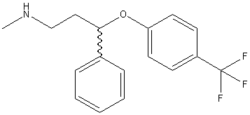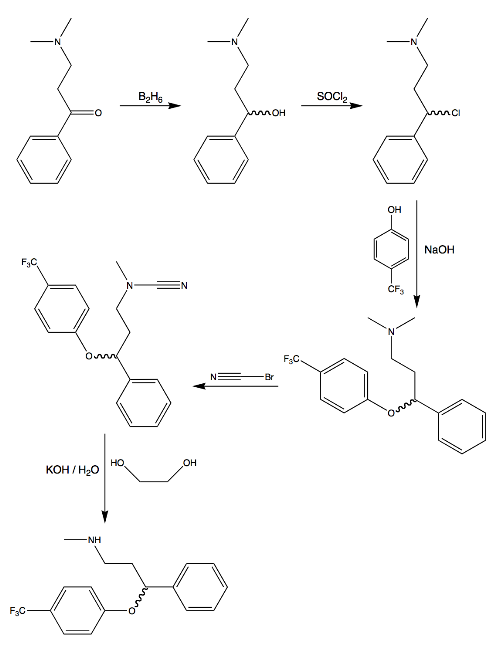Fluoxetine Hydrochloride (Prozac)
Fluoxetine Hydrochloride, much more commonly refered to by it's trade name of Prozac, is a drug which is very common in everyday life. It is prescribed to over 54 million people throughout the world making it the most prescribed antidepressant in the world. Prozac is commonly prescribed to combat illnesses such as Bulimia nervosa and depression as well as panic disorder and Obsessive Compulsive Disorder (OCD).
History
Prozac[1] is a drug which is patented by the American pharmaceutical giant Eli-Lilly. Work on the molecule is thought to have begun in the early 1970's and continued until prozac was finally launched onto the drug market in 1986. Since then the use and prescription of Prozac has gone from strength to strength.
Work to synthesise Prozac followed a common pattern for the formation of a new molecule, involving many years work. This all began in 1970 at Eli Lilly with the observation that antihistamine diphenhydramine displayed anti-depressant qualities. Taking this knowledge and using 3-Phenoxy-3-phenylpropylamine as a readily available and suitable starting point a large number of comparable derivative molecules. After much work and research a final structure, finally named as fluoxetine, was determined. The knowledge was then published and a patent applied for.
Prozac was finally approved for use by the Food and Drug Administration (FDA) of America and from then has been used as a suitable anti-depressant. The Eli Lilly patent for Prozac ended in 2001 and as a result since then a large number of Prozac forms have entered the market.
Mechanism of Action
Fluoxetine[2] is a selective serotonin reuptake inhibitor (SSRI). This works by inhibiting reuptake of serotonin back into the presynaptic cell. This means that the amount of neurotransmitter available for transmission of signal is reduced. This results in serotonin remaining in the synapse as opposed to being taken back up.
Understanding how this affects depression requires the link of depression to a limited stimulation of the recipient neuron. As the SSRI prevents serotonin being taking back up this means it remains in the synapse and can repeatedly stimulate the recipient neuron and as such prevents depression.
Synthesis
Pharmacology
Prozac is a useful molecule clinically, as well as treating depression it has been found to treat a number of other common complaints. For example it can be used to treat OCDs (Obsessive Compulsive Disorder) as well as ADHD (Attention-Deficit Hyperactivity Disorder), as well as numerous other neurological disorders. Prozac is sold as capsules, typically around 20mg per capsule. The lowest known toxic dosage of Prozac being 520mg. The degradation of Fluoxetine occurs in the liver. The liver performs metabolism on fluoxetine to form norfloxetine, involving the removal of the NCH3 group, which can then be removed.
Side Effects
- Allergic or Toxic - Rash, Pruritus (skin inflammation)
- Neurological - Headache, Tremor, Dizziness, Asthenia
- Behavioural - Insomnia, Anxiety, Nervousness, Agitation, Abnormal dreams, Drowsiness and fatigue
- Autonomic - Excessive sweating
- Gastrointestinal - Nausea, Disturbances of appetite, Diarrhoea
- Respiratory - Bronchitis, Rhinitis (inflammation of the nasal mucous membranes), Yawning
- Endocrine - Weight loss
- Musculoskeletal - Muscle pain, Back pain, Joint pain
- Urogenital[4] - Painful menstruation, Sexual dysfunction, Urinary tract infection, Frequent micturition
- Miscellaneous - Chills
References
- ↑ http://www.prozac.com
- ↑ http://en.wikipedia.org/wiki/Fluoxetine
- ↑ http://www.nitrogenorder.org/molweek/sep2005/04sep05.shtml
- ↑ www.panic-anxiety.com/articles/prozac-fluoxetine/


